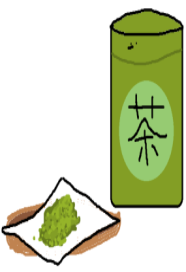| The fun world of Japanese tea |
| Here, the history of Japanese tea and differences in cooking methods are
explained roughly. |
A Brief History of Japanese Tea
At first, tea was mainly used as a medicine, but it wasn't until Kamakura period monk "Eisai" introduced matcha to Japan. After that, Sen no Rikyu completed the system of the tea ceremony, and in the Edo period, the custom of drinking sencha became common as it is today.
Tracing its origins, the culture of tea introduced from China underwent
a unique development after it entered Japan. |
 |
Production methods and characteristics of each type of Japanese tea
・Sencha the most common Japanese tea. Sun-grown tea leaves are steamed, kneaded and dried. It has
a good balance of sweetness, astringency, and aroma.
・Gyokuro cover the fields,
High-class tea made from tea leaves grown in shade. It has a strong umami, sweetness, and a strong aroma. Matcha is made by grinding this.
・BanchaTea leaves that have become hard due to overstretching.
Tea made from tea leaves harvested by pruning tea leaves. It is characterized
by strong astringency and refreshing taste. |
 |
・Hojicha Bancha is roasted (Horoku) and has a unique aroma of roasted tea. It's weakly stimulating, so it's easy to drink regardless of age or gender.
・Genmaicha Bancha or Sencha mixed with roasted brown rice. It has a fragrance different from hojicha, and is highly popular as a tea for everyday use.
・Konacha This is a tea made only from powdered tea leaves. There is a base for sencha and a base for gyokuro. It has a strong flavor and is familiar as a tea for sushi restaurants.
(Right image) |
 |
 
|

